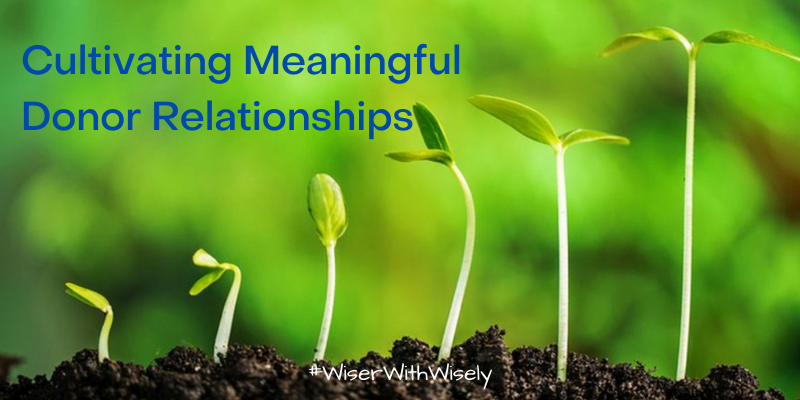
Building meaningful relationships with the donors and prospects in your fundraising portfolio is the best way to grow your nonprofit’s revenue over time. Last week on #WiserWithWisely we discussed how to build meaningful relationships with your donors and prospects through cultivation and stewardship.
This week we are going to dive deeper into cultivation tactics to build donor relationships and how your fundraising portfolios can help. This post also includes some tips to use your nonprofit’s case for support to – not only solicit major gifts – but to cultivate meaningful donor relationships.
Introduce Yourself
The first step in building a relationship with donors and prospects is to introduce yourself of course! When you introduce yourself to a new donor or prospect you want to put your best foot forward and show them that you are just as invested in the nonprofit’s mission as they are, someone they can trust with fulfilling their philanthropic goals.
The introduction is important for new prospects, or for new fundraisers who have recently joined the team, but that doesn’t mean you should shy away from reaching out to re-introduce yourself to long-standing donors to your organization. These are great people to build a deeper relationship with and getting to know them better can give your fundraising team good insights into your donors’ philanthropic goals.
Tips for introducing yourself to donors and prospects:
- Use your case for support as a reason to reach out (there’s more on this below!).
- Send an email or plan to make a quick call to set up a time to meet. Donors may not be ready to have a full conversation at the drop of a hat and will appreciate the time to prepare.
- Don’t talk about the money right away! Share why the nonprofit mission is important to you and what you’re excited about so the donor can see that you’re invested in the nonprofit’s work.
- Focus on just having a conversation to start out with, but be transparent about your intentions if the donor or prospects asks you if they’re going to be solicited for a donation.
Get to Know Your Donors
A relationship goes two ways, so while it’s important that your prospects and donors get to know your fundraisers and your nonprofit. It’s equally important that your fundraisers get to know your donors and prospects in order to build a meaningful relationship.
Showing interest in your prospects and donors, including their philanthropic goals, demonstrates that they are partners with your nonprofit and not just a source of cash. Getting to know your prospects is critical for putting together the ideal major gift proposal that will align with their philanthropic interests and goals.
If you need some tips for getting to know your donors, check out this #WiserWithWisely post: Easy Communications Hacks to Get to Know Your Donors.
The Role of Your Case for Support
Your case for support plays a huge role in cultivating a relationship with your donors and prospects – especially your prospects as the case for support will help them understand your nonprofit’s work and how their donation can help.
What is a Case for Support?
A case for support is a document that your fundraising team can use to present your nonprofit’s mission and how donations are used. It can be as simple as a text document with a few pictures, but often cases for support are designed in a brochure or magazine-like style with different sections and many visual elements.
A case for support generally includes:
- Background information about the nonprofit
- Information on the mission of the nonprofit, the issue that they are trying to solve including some statistics
- Examples of how the nonprofit has helped solve the issue
- And the most important part, how donations are critical so solving the issue
Cases for support can be general for your nonprofit’s work as a whole or they can be written for specific projects or campaigns.
Using Your Case for Support in Cultivation
While your nonprofit’s case for support is ultimately focused on giving, you don’t need to use the case as part of donor solicitation. Your case for support can provide an introduction to your nonprofit and its mission for new prospects. Information like your nonprofit’s background and why your mission is important are critical pieces in building meaningful relationships with donors and prospects.
Here are some ideas for your fundraising team to use the case for support to introduce themselves to donors and cultivate meaningful relationships:
- Send the case for support in advance of a meeting with a prospect or donors and then use it as a conversation starter.
- Discuss how the donor or prospect sees themselves playing a part in your nonprofit’s mission.
- Use the case to find out if there are specific aspects of your work that a prospect or donor is interested in so you can put forth a tailored proposal.
Once you’ve taken care of building meaningful relationships with your donors and prospects it’s time to consider how you will manage your fundraising portfolio year over year to build your fundraising program. Next week on #WiserWithWisely we’ll share some tips on using your fundraising portfolio year over year to build donor relationships and grow revenue for your nonprofit.